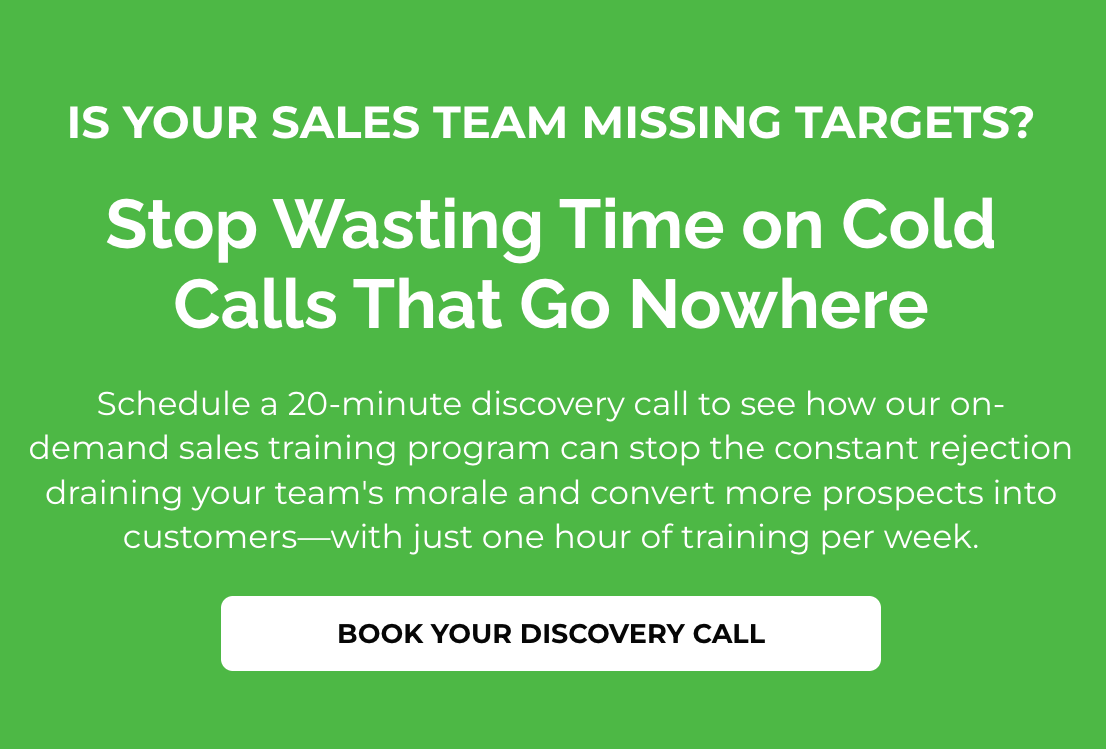Which Sales Training Methods Get the Best ROI for SMB?

Is Sales Training ROI Possible for SMBs?
Sales training is often viewed by SMB’s (small to mid-size business) companies as an expense. A short-term boost of motivation that quickly evaporates.
It’s hard not to see that viewpoint. How many times have you watched a sales team go through a whole or half-day sales training program on a Monday, just to be back in their bad habits by Thursday? It’s tough to get an ROI (Return on Investment) when so many programs fade like bubble-gum.
Enterprise-level companies know the real value of on-going sales training and have budgets for in-house and outsourced sales training solutions. They are continually feeding their sales teams with fresh new perspectives to stay ahead of their competition.
After all, the quickest way to hit your business goals is through sales. That’s why, according to LinkedIn’s The State of Sales Report, in the U.S. alone, companies spend $15 billion each year training sales employees and $800 billion on incentives to retain sales talent.
Enterprise companies are gobbling up top sales personnel and investing heavily to make sure their assets stay, making it even harder for the SMB companies to succeed.
Where Enterprise companies can invest 10’s of thousands and even 100’s of thousands of dollars per year on sales training and go from one program to the next, small to mid-size companies can’t afford to make a mistake. They need to get an ROI from whichever program they decide to try.
Which Sales Training Methods Get the Best ROI for SMB’s?
With so many different labels, all touted as being better than the previous one; it’s hard to pick which sales training method is the best fit for your team.
To make matters worse, the barrier to become a “sales trainer” is at an all-time low. There are lots of influencers with self-published books that make high-energy videos and LinkedIn posts as to why they are the right choice, yet, would most likely fail if they had to pick up the phone and sell using their tactics.
On top of that, the acronyms for different “styles” or methods of sales training seem to change year after year.
We’ve gone from:
Cold Calling > Solution Selling > Social Selling > Insight Selling, and so on.
Cold Calling Method
Let’s start with the OG (Original Gangster).
90% of the sales books IMHO mislead their readers about what cold calling is. They do so for one of two reasons: They don’t know what they’re talking about, or they are trying to sell you on their solution.
If someone tells you that you shouldn’t make cold calls and with the same breath, they tell you to research the prospect first to “warm-up” the call, this person doesn’t have a clue on what is and what isn’t Cold Calling.
The definition of cold-calling is contacting any prospect that is NOT currently raising their hand.
That means you can do all the research on a prospect that you want, but you knowing about them doesn’t make them a warm lead.
The same goes for “referral” sales trainers too! Referral “boasters” love to tout and say you shouldn’t cold call, and they list all the reasons why you shouldn’t – and I get it! Cold calling is TOUGH. It requires sharp sales skills.
But calling your best clients and pressuring your acquaintances, LinkedIn contacts, and friends to give you names of prospects doesn’t warm up the call for the prospect. It’s still a cold call when you contact them out of the blue and say, “I got your name from…”
There’s nothing wrong with the referral strategy, and you should do a little research on your prospects, but unless they raised their hand, it’s still a cold call. So, let’s not pretend that it isn’t.
Solution Selling Method
I love solution selling because no matter if the lead is outbound or inbound, solution selling typically means you focus on establishing a problem and getting agreement that a problem exists, first.
A prospect that recognizes a problem is more likely to want to hear about a solution to solve the issue at hand, no matter if it was an outbound (cold call) or an inbound (warm) lead.
When you’re cold calling, most prospects don’t know they have a problem.
If they did know they had a problem, they would have Googled for a solution and would have been an inbound “warm” lead.
If you’ve ever cold-called a prospect, asked a few probing questions and then presented your solution only to hear “Sounds good but I think we’ll just stick with what we have,” the problem wasn’t that it was a cold call.
The problem was you never got the prospect first to recognize a problem or agree that an issue existed and that they wanted to solve it. The lack of sales skills cost you the sale, not the method.
It’s not enough to ask the pain point questions when solution selling. You have to listen and interpret how the prospect is responding.
Think of sales as baseball. You’re rounding first base headed to second base, but if your sales questions failed to establish problem recognition, and you move forward with the sale anyway, you’re going to get tagged out.
This is the critical sales skill most failing sales reps never understood. It wasn’t the fact that the lead was cold or that the solution selling method didn’t work. It was the fact that the salesperson didn’t/doesn’t know how to spark a conversation and uncover what the problems are.
Social Selling Method
Back in the mid to late 2000’s it was becoming increasingly easy to use social media to generate inbound leads. It gave birth to social selling. You no longer needed large marketing budgets to drive in leads. You just had to have some marketing creativity and grit.
The reason so many sales reps struggle to make quota using social selling alone is because they incorrectly assume that if a lead were generated inbound, then all the salesperson would have to be is “friendly.”
They hid from the fact that their sales skills were weak and latched on to the “people buy from people they like” mantra and thought they would survive. They were wrong.
Of course, nobody buys from someone they DON’T like. So saying people buy from people they like is a little like saying the sky is blue.
Social selling should be called social marketing. You’re using the free to low-cost tools to brand you and your company as an expert in your field, and if you’re an SMB, you should be doing that.
It attracts and brings in leads as well as builds your brand so that when a trigger event happens in a prospect’s life, they remember who to reach out to. Nothing wrong with that. It’s a smart way to stay top of mind and generate inbound leads.
The problem salespeople have, when the inbound lead comes in, a lot of them lack the sales skills needed to increase their chances of closing the deal. Don’t take my word for it, be a secret shopper, and be an inbound lead to your own sales team. I’ll wait. I’m willing to bet most companies would be horrified by how their sales reps handled the call.
There’s always the never-ending debate on if your outbound sales reps should spend time “social selling” and my answer is a firm NO. And I’m not alone.
Becc Holland, Head of Sales Development at Chorus.ai, agrees:
“Nearly every top – performer that has worked on my teams who were top of leader board in terms of quota-attainment, had ZERO social presence – So I KNOW you don’t need it to be successful.
They spent their time honing in on their craft of cold calling, bettering their email skills, & sending cold outreach INSTEAD of developing a podcast or spending endless hours scrolling through LinkedIn.
It’s a time suck. It’s ok to do it in moderation, if you’re a content marketer, OR a consultant where your social presence IS your own marketing engine.
But if it’s your average everyday AE or SDR, ESPECIALLY if they aren’t selling into SDR Leaders or Sales Leaders as an ICP… It can be a really tricky distraction, and does more damage by eating up their time they could be spending prospecting than good.
On a side note, I know several people with a BIG personal brand, who are looking for jobs right now, and can’t find one. So I don’t think it even does THAT much for your career trajectory.”
If you’re an SMB company, having the life-blood of your organization tweeting instead of picking up the phone, is a recipe for disaster.
Prospects are attracted to SME’s. That stands for SUBJECT MATTER EXPERT.
Is your new hire, the one fresh out of college, really the SME of your brand?
Besides, the average new sales hire leaves after 15-months, according to the Bridge Group.
Another false prophecy from social selling trainers is that the buying process has changed. They say that to make you think your sales process is broken and outdated. And maybe it is, but that’s not because the sales process has changed or because prospects have more access to information like ever before.
Even when an educated prospect is an inbound (warm) lead, unless the first words out of their mouth are “I want to buy your ____,” you still need to have a sales conversation with them.
The responsible thing to do with an inbound lead is to confirm or deny your solution is the best choice for their needs. And to do that, you’ll need to ask them some questions.
When the inbound leads spigot slows to a drip, and it always does, you’ll need to pick up the phone, pique interest, and engage your prospect in a sales conversation by asking questions to determine if a problem exists.
After all, no one buys solutions unless they want to solve a problem.
Insight Selling Method
Ex-Googler and CEO Founder of Node, Falon Fatemi, wrote an article about how Insight Selling is the new Solution Selling. The argument that the Solution Selling method was dead was based on the premise that “B2B buyers are coming to the table more prepared and better educated than ever before.”
Even so, and especially so, assuming a prospect is fully educated on the problem they are trying to solve, let alone the solutions available, is a recipe for disaster.
You might as well just higher customer service reps to be at the inbound leads beck and call and hope the inbound lead flow never decreases.
I don’t have a problem calling it Insight Selling vs. Solution Selling. The problem lies within the execution, not what the current trend is to name a sales process.
At the end of the day, whether you have inbound leads, rely on outbound, or a combination of the two, you need a sales team that can execute the basic fundamental sales steps better than your competitors.
And to do that, you’ll need to continually invest in them if you want the highest possible ROI.
“But what if we train them and they leave?”
I like Sir Richard Branson response to this question:
“Train people well enough so they can leave, treat them well enough, so they don’t want to.”
That’s how you get the ultimate ROI.
– Michael Pedone
Founder of SalesBuzz.com. Online Sales Training Programs that Engage – Live Online Workshops for B2B Inside Sales Teams.

